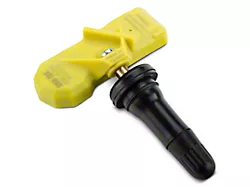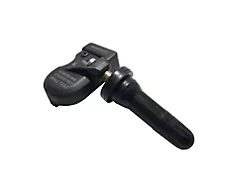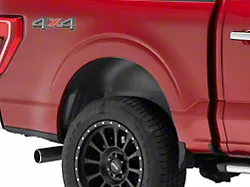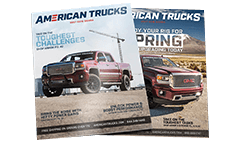
How to Install SkyJacker 4 in. Standard Suspension Lift Kit w/ Shocks (07-13 4WD Sierra 1500) on your GMC Sierra
Tools Required
- Safety Glasses
- Metric / Standard Wrenches & Sockets
- Drill / Assorted Drill Bits
- Cut Off Wheel / Grinder
- Floor Jack
- Jack Stands
- Measuring Tape
- Torque Wrench

Shop Parts in this Guide

Important Notes:
• This 4" lift is designed for models that are not equipped with autoride / self leveling suspension.
• If larger tires (10% more than the OEM diameter) are installed, speedometer recalibration will be necessary. Contact your local GM dealer or an authorized dealer for details.
• After installation, a qualified alignment facility is required to align the vehicle to the OEM specifications.
Front Installation:
1. With the vehicle on a level concrete or asphalt surface, set the emergency brake & block the rear tires / wheels. Place a floor jack under the lower control arm front cross member & raise the front of the vehicle. Place jack stands under the frame rails behind the front wheel wells & lower the frame onto the jack stands.
2. Remove the front tires / wheels using a 22mm socket. (See Photo # 1)
3. Remove the OEM outer tie rod end nuts from the OEM steering knuckles using a 18mm socket & disconnect the OEM outer tie rod ends from the OEM steering knuckles. (See Photo # 2) Note: It may be necessary to strike the side of the OEM steering knuckles to dislodge the OEM outer tie rod ends. Be careful not to damage the OEM outer tie rod ends.
4. Disconnect the OEM brake calipers from the OEM brake rotors & disconnect the OEM brake lines from the OEM upper A-arms. (See Photo # 3) Note: Simply wire the OEM brake calipers out of the way. It will not be necessary to disconnect the OEM brake lines from the OEM brake calipers.
5. Remove the OEM sway bar end links using a 15mm socket. (See Photo # 4)
6. Remove the OEM strut assemblies by removing the lower mounting bolts & upper strut retaining nuts. (See Photo # 5)
7. Disconnect the OEM upper & lower A-arms from the OEM steering knuckles using a 18mm socket. Note: It may be necessary to strike the side of the OEM steering knuckles to dislodge the OEM ball joints. Be careful not to damage the OEM ball joints. (See Photo # 6)





8. Remove the OEM CV axles using a 15mm socket. (See Photo # 7)
9. Remove the OEM front skid plates using a 15mm socket. Disconnect the OEM lower A-arms using a 18mm & 24mm socket.
10. Remove the OEM rear cross member using a 18mm socket. (See Photo # 8)
11. Disconnect the OEM front drive shaft from the front differential & support the front differential using a transmission jack. Remove the OEM front differential mounting bolts using a 15mm & 18mm socket & remove the front differential. (See Photo # 9) Note: It will be necessary to cut / grind two fins from the OEM front differential. Remove the rearward fin completely & grind smooth. Grind the forward fin so it is even with the rear fin. (See Photo # 10)
12. To reinstall the OEM front differential, install the new Skyjacker aluminum front differential spacers between the OEM front differential mounts & the frame using the supplied 12mm x 120mm bolts, washers, & nuts. (See Arrow In Photo # 11) Note: The thicker (1" thick) spacers are for the front mounts & the thinner (.875" thick) spacers are for the rear mounts.
13. Reconnect the OEM front drive shaft using the OEM hardware.
14. Install the new Skyjacker rear cross member using the supplied 5/8" x 5 1/2" fine thread bolts, washers, & nuts. (See Photo # 12)





15. Install the new Skyjacker aluminum front cross member spacers between the new Skyjacker front cross member & the frame. Install the new Skyjacker front cross member using the supplied crush sleeves, 5/8" x 5 1/2" fine thread bolts, washers, & nuts. (See Photo # 13)
16. Attach the OEM A-arms to the new Skyjacker front & rear cross members using the OEM hardware. (See Photo # 14)
17. Remove the OEM hub bearing assemblies from the OEM steering knuckles using a 15mm socket. Install the OEM hub bearing assemblies to the new Skyjacker steering knuckles using the OEM hardware. (See Photo # 15)
18. Install the new Skyjacker strut spacers on the top of each OEM strut assembly using the OEM hardware & 18mm wrench. (See Photo # 16)
19. Install the upper mount of the strut assemblies using the supplied 10mm nuts. (See Photo # 17) Install the lower mount of the strut assemblies using the OEM hardware. (See Photo # 18)
20. Attach the new Skyjacker steering knuckles to the upper & lower A-arms using the OEM hardware. Install the new Skyjacker CV axle spacers & OEM CV axles using the supplied 10mm x 50 mm bolts & thread locking compound. (See Photo # 19)





21. Install the new Skyjacker ABS line & brake line brackets to the frame using the supplied 5/16" x 1" fine thread bolts, washers, & nuts. (See Arrows In Photo # 20)
22. Attach the OEM outer tie rod ends to the new Skyjacker steering knuckles using the OEM hardware. Reinstall the OEM brake rotors & OEM brake calipers using the OEM hardware.
23. Install the new Skyjacker sway bar end links using the supplied gold washer on top of the OEM A-arm & the supplied nut on the bottom of the OEM A-arm. Note: Install the new sway bar end links with the pivoting end at the A-arm. (See Photo # 21)
24. Install the front tires / wheels using a 22mm socket & lower the front of the vehicle to the ground.
Rear Installation:
1. Block the front tires / wheels, raise the rear of the vehicle, & properly support the frame rails using jack stands.
2. Remove the rear tires / wheels using a 22mm socket.
Pick-Up Models:
3. Support the rear differential & remove the OEM rear shocks & OEM U-bolts.
4. While checking for appropriate slack in ABS lines, brake lines, differential breather hose, & etc. Lower the rear axle & install the new Skyjacker 2" rear lift blocks on top of the OEM rear blocks. Install the new Skyjacker U-bolts using the supplied 9/16" fine thread nuts. (See Photo # 22)
SUV Models:
5. Support the rear differential & remove the OEM rear shocks.
6. Remove the OEM rear sway bar end links. (See Photo # 23)




7. Remove the OEM lower control arms & install the new Skyjacker rear lower control arms using the OEM hardware. (See Photo # 25) Note: Remove one side at a time so the axle is not free to move. (See Photo # 24)
8. Install the new Skyjacker bump stop brackets to the OEM bump stop pads so the lip of the new bump stop brackets catch on the front of the OEM bump stop pads. Install using the supplied 3/8" x 1” fine thread bolts, washers, & nuts. Note: The 3/8" bolts will install from under the OEM bump stop pads through the new bump stop brackets. (See Photo # 26)
9. While checking for appropriate slack in ABS lines, brake lines, differential breather hose, & etc. Lower the rear axle & remove the OEM rear coil springs. Install the new Skyjacker rear coil springs using the OEM rubber isolators.
10. Install the new Skyjacker rear sway bar end links using the supllied 1/2" x 3" fine thread bolts, washers, & nuts. (See Photo # 27)
11. Install the new Skyjacker rear shocks using the supplied hardware & OEM hardware.
12. Install the rear tires / wheels using a 22mm socket, & lower the rear of the vehicle to the ground.
Final Notes:
• After the installation is complete, double check that all nuts & bolts are tight. Refer to the following chart for the proper torque specifications. (Do not retighten the nuts & bolts where thread lock compound was used.)
• With the vehicle placed on the ground, cycle the steering lock to lock & inspect the steering, suspension, brake lines, front & rear drivelines, fuel lines, & wiring harnesses for proper operation, tightness, & adequate clearance.
• Have the headlights readjusted to the proper settings.
• Have a qualified alignment center align the vehicle to the OEM specifications.
• After the first 100 miles, check all of the hardware for the proper torque & periodically thereafter.





• The above specifications are not to be used when the bolt is being installed with a bushing.











